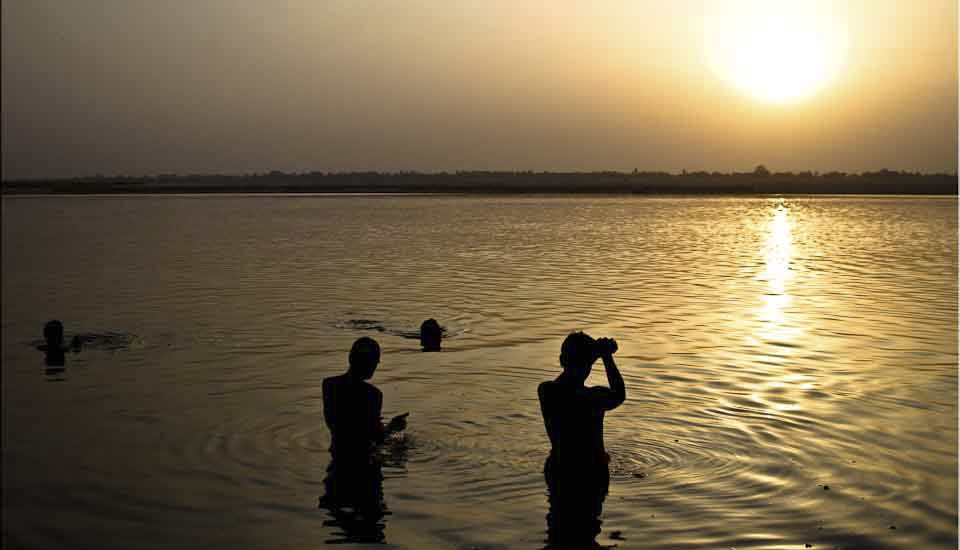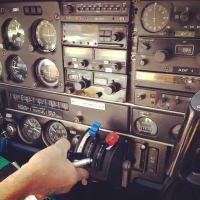.jpg)
Epupa Falls
Epupa Falls is a series of cascades stretching about 1.5km through the Kunene Region. This is the northern-most point in Namibia, where the Kunene River forms the border with Angola.
(ISO100 16mm f/16 30sec Crop)
It is a primordial landscape, born out of the very heart of the pre-Jurassic Gondwana super-continent.
The Kunene Region in Northern Namibia is dry, mountainous, and underdeveloped. It is home to semi-nomadic tribes whose ways of life have barely changed for hundreds of years (see: Women of the Himba, and Himba Model Shoot).
The Kunene River, which starts in the Angolan highlands and runs 1,050 kilometres to the Atlantic Ocean, is the only perennial river within the ecoregion. The river marks the Angola-Namibia border and tumbles over Epupa Falls at a gorge formed between 2,100 million and 1,750 million years ago.
Although the time-lines are wildly different, I had no trouble imagining dinosaurs walking among the primitive baobab trees that cling to the rocky river banks.
That was, of course, once we got there.
I and four other photography enthusiasts were travelling with photographer Ben McRae and local guide, driver, chief cook and bottle-washer, Morne Griffiths, across the vast expanses that comprise Namibia.
I knew we’d be camping for the next several nights, so I treated myself to a small cabin with a plywood bed the night we stopped in Kamanjab, and enjoyed a decent sleep and a shower with water so splayed that I got my exercise dancing around, trying to get wet without getting scalded; facilities in Namibia can be “rustic”. After a very early hot breakfast, we started our journey of 440 kilometres north through the dry winter landscape dressed in subdued autumnal colours; about six bumpy hours past hornbills perched on electrical wires, ostriches and giraffes loping in the distance, and long-horned cows and humped brahman along the roadside. Gradually, the thorn trees gave way to palm forests, and we came across our first giant baobabs.
Nothing, though, prepared me for the magnificent Epupa Falls.
Join me in Namibia’s timeless Kunene.
.jpg)
Rosy-Faced Lovebird (Agapornis Roseicollis)
The sun wasn’t yet up and the winter air was still cold – but the birds were already gathered around the feeder in the rest-camp courtyard in Kamanjab.
.jpg)
View from the Truck
We set off early morning, heading out on the long, dusty roads north to Epupa. (iPhone6)

Baobab
The mighty baobas (Adansonia digitata) grow along the side of the road.

“Make your Mark”
There is an African proverb: “Knowledge and wisdom are like a Baobab tree, one person’s arms cannot encompass it.” The trunks are huge, with an average diameter of 5 m (16 ft).

Scars and Textures
Baobab trees frequently live for between 1,000 – 3,000 years. Their succulent trunks have a high resistance to drought and fire.

Look Up!
In the right soil, baobabs grow quickly, and can reach between 5–25 m (16–82 ft) in height.

Nests in the Branches

Cairn or Shrine

View from the Truck
Leaving the baobab tree behind, we rejoin the the road and climb the rocky hills to Epupa. (iPhone6)

Above Epupa Falls
After pitching our tents in the allocated camping spot, we join the other visitors on the dry, rocky terrain above the falls.
(ISO200 70mm f/4 1:320sec)

Afternoon above the Falls
The afternoon sun still packs heat as the shadows deepen and grow longer. It is not as quiet as it looks, however: the roar of the falls, just hidden from sight, is palpable.
(ISO200 24mm f/11 1:100sec)

Epupa Falls
Nothing had prepared me for the first sight of the magnificent falls, with the waters of the Kunene tumbling straight down the rocky gorge separating Namibia from Angola.
(ISO200 70mm f/3.5 1:400sec)

Below the Falls
Before sun-up the next morning, I grabbed a head-lamp and tripod and picked my way carefully over the jagged, primordial landscape below the main falls. Countless waterfalls tumble into the river below from all directions.
(ISO 100 70mm f/25 3.2sec)

Morning on the Falls
(ISO6400 200mm f/2.8 1/400sec)

Solitude
As early as I was, I wasn’t the first. Photographer Ben McRae had already found a spot on the ancient rocks.
(ISO800 16mm f/2.8 1/100sec)

Sunrise
(ISO200 24mm f/5.6 1/200sec)

Sunrise
(ISO100 70mm f/32 3.2sec)

Below the Falls
Epupa Falls are thought to be the oldest rock formation in Namibia, between 2,100 million and 1,750 million years old.
(ISO400 35mm f/6.3 1/60sec)

Kunene River
As the sky finally lightens, the green river contrasts with the ancient rocks of the gorge.
(ISO100 16mm f/5.0 1/60sec)

Water on the Rocks
(ISO100 200mm f32 2.0sec)

Morning Light on the Baobabs
The spray from the falls backlights the baobabs.
(ISO100 175mm f/32 0.8sec)

Angola over the River
Angola looks wild and empty across the river.
(ISO100 30mm f/7.1 1/60sec)

Baobab Trees
The giant baobabs have a shallow roots, spreading further than the height of the trees, allowing them to cling to the river banks and survive the dry climate.
(ISO400 70mm f/8.0 1/400sec)

Baobab Trees
It’s a pre-historic landscape: baobab trees are among the oldest living trees in the world.
(ISO100 70mm f/2.8 1/400sec)

Leaves on a Baobab Tree
To conserve moisture, baobabs only have leaves about three months a year, during the wet season.
(ISO100 35mm f/14 1/60sec)

Top of the Falls
(ISO100 200mm f/32 0.6sec)

Top of the Falls
“Epupa” is a Herero word for “foam”; the falls are named for the the foam created by the tumbling water.
(ISO200 70mm f/5.6 1/400sec)

Girls at the top of the Falls
The morning sun lights up this “foam” at the rocky top of Epupa Falls.
(ISO100 200mm f/2.8 1/400sec)
Since 2012, Himba chiefs have been protesting against a proposed dam on the Kunene River in the Baynes Mountains. The dam might bring in economic development to the region but would irreparably change the traditional ways of life, and this ancient landscape itself.
 Development is not always “progress”.
Development is not always “progress”.
Until next time.
Pictures: 15-16August2015
































.png)


[…] after breaking camp the day before at Epupa in northern-most Namibia (see: North to Epupa) – and had entered Etosha National Park just before noon. Our first […]
[…] Omarunga Camp, within earshot of the magnificent Epupa Falls on the Kunene River (see: Landscapes of the Kunene). Our trip-organiser, photographer Ben McRae had a shoot planned for the late afternoon, and it was […]
[…] near the magnificent Epupa Falls in northwestern Namibia is an extraordinary experience. Not only is the […]